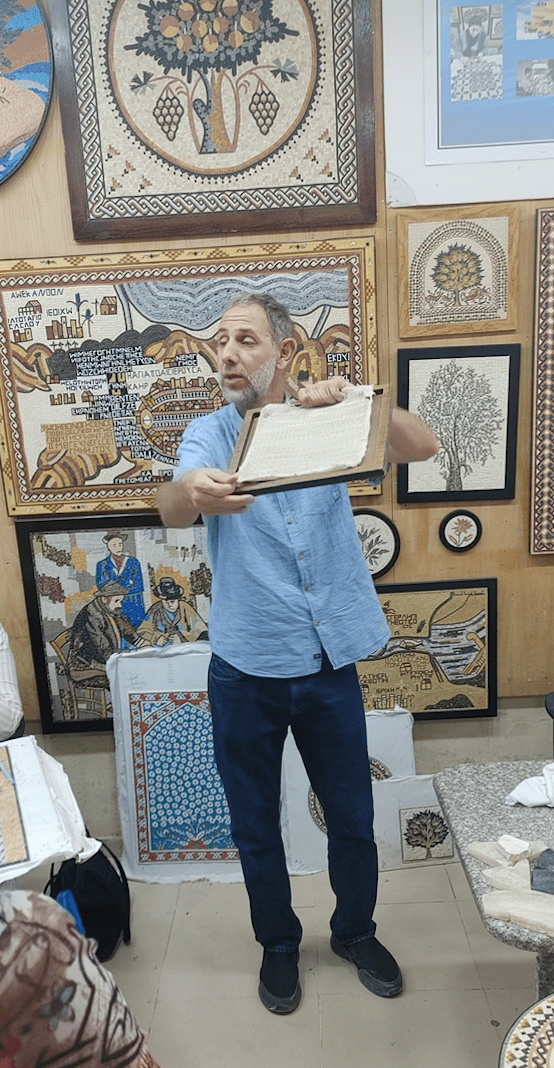Mosaics recall country's past
Jordan Jewel Art & Mosaic staff are literally helping preserve a long-standing Jordanian art form in bits and pieces.
Jordan Jewel Art & Mosaic has employees making mosaics that are sold to visitors, with shop manager Anas Bani-Hani reporting that the tiny tiled artworks were introduced into Jordan by Greeks over 2,000 years ago and figure prominently in the country’s historical sites, including Madaba, where his enterprise is based.
But production of mosaics in this day and age has dwindled, something Jordan Jewel Art & Mosaic wants to change.
“One of the main goals of the program is to revive it,” Bani-Hani says of production of mosaics, which were made at many sites around the Mediterranean by the Greeks and Romans long ago, creating an art form adopted by later adherents to Islam. “We’re making a very solid base for this handicraft to live on and on,” he says.
Mosaics were a symbol of luxury in ancient times, being found in the likes of churches, temples, palaces and homes of the wealthy.
Jordan Jewel Art & Mosaic — which opened in 2008 — now has some 62 employees working on site and 45 others working at home, creating mosaics of varying sizes and with differing images, some of those images historical and others displaying everyday life scenes or animals, such as cats and horses. Workers initially receive months of free training from an operation that’s affiliated with Jordan’s Queen Noor Foundation Community Development Initiative.

The works are sold in the gallery, with DHL shipping purchases to the buyers’ homes for free, lending a helping hand to a program aimed at helping revive not only a storied tradition but also ease high regional unemployment.
Available artworks can also include tables and pottery coated with mosaics.
Madaba is seemingly a great venue for the art form, with a community that flourished during the Roman era now home to the Madaba Institute for Mosaic Art and Restoration and having long-standing structures where mosaics dating back to ancient times have been uncovered. Those structures include a church found atop nearby Mount Nebo — from which Moses purportedly saw the Promised Land — home to remarkable Byzantine-era mosaics.
Bani-Hani says producing a single one-square-meter mosaic — far from the largest on display at Jordan Jewel Art & Mosaic — may take weeks as a staffer painstakingly assembles small tiles on the way to creating an image.
Jordan Jewel Art & Mosaic has shipped over 8,000 mosaics abroad that collectively represented over 2 million cumulative hours of labour. The tiles themselves are made from discarded stone gathered by Bani-Hani from sites in Amman. Some Jordan Jewel Art & Mosaic mosaics are ordered by customers who make specific requests.
Jordan Jewel Art & Mosaic won the admiration of visiting Las Vegas travel agent Abby Lagman.
“I’m very into any organization that supports the empowerment of women and others who are often overlooked,” she says. “And it’s nice to see beautiful, handmade, authentic products.”
Detroit-area travel agent Patty Monahan in turn says she enjoyed learning about the making of the mosaics and meeting some of those who create them.
“It’s uplifting to see what they’re doing to keep the tradition alive and employing local people,” she says.
Monahan bought a “meaningful” mosaic depicting the cycle of life. “I will always think of her (mosaic creator Ashjan) and Jordan when I look at it back home.”
Bani-Hani says Madaba and Jordan Jewel Art & Mosaic are now doing more than their part to ensure mosaics will continue to be a part of Jordan’s future and also offer tourists skillfully made reminders of their Jordan vacations.
“I challenge that we have the best mosaics in the world and I’m proud of that,” he states. “You (Jordan Jewel Art & Mosaic visitors) can buy a beautiful piece of art ready to last 2,000 years. We guarantee our products better than Mercedes-Benz.”
More information is available at jordanjewel.com.

















